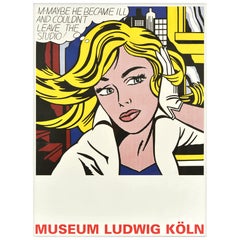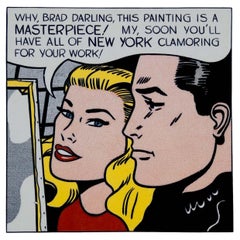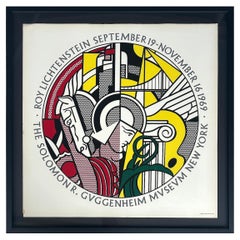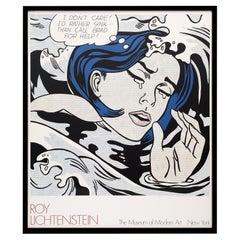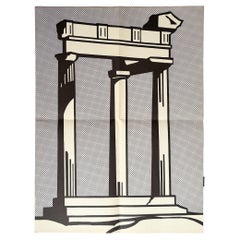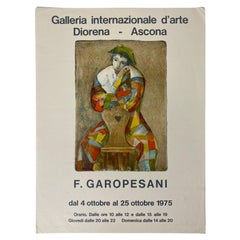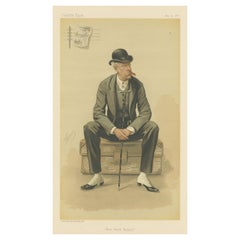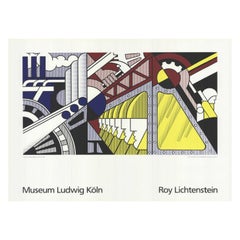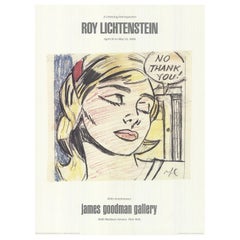Roy Lichtenstein Wall Decorations
Roy Lichtenstein is one of the principal figures of the American Pop art movement, along with Andy Warhol, James Rosenquist, Claes Oldenburg and Robert Rauschenberg.
Drawing inspiration from comic strips, Lichtenstein appropriated techniques commercial printing in his paintings, introducing a vernacular sensibility to the visual landscape of contemporary art. He employed visual elements such as the halftone dots that comprise a printed image, and a comic-inspired use of primary colors gave his paintings their signature “Pop” palette.
Born and raised in New York City, Lichtenstein enjoyed Manhattan’s myriad cultural offerings and comic books in equal measure. He began painting seriously as a teenager, studying watercolor painting at the Parsons School of Design in the late 1930s, and later at the Art Students League, where he worked with American realist painter Reginald Marsh. He began his undergraduate education at Ohio State University in 1940, and after a three-year stint in the United States Army during World War II, he completed his bachelor’s degree and then his master’s in fine arts. The roots of Lichtenstein’s interest in the convergence of high art and popular culture are evident even in his early years in Cleveland, where in the late 1940s, he taught at Ohio State, designed window displays for a department store and painted his own pieces.
Working at the height of the Abstract Expressionist movement in the 1950s, Lichtenstein deliberately eschewed the sort of painting that was held in high esteem by the art world and chose instead to explore the visual world of print advertising and comics. This gesture of recontextualizing a lowbrow image by importing it into a fine-art context would become a trademark of Lichtenstein’s artistic style, as well as a vehicle for his critique of the concept of good taste. His 1963 painting Whaam! confronts the viewer with an impact scene from a 1962-era issue of DC Comics’ All American Men of War. Isolated from its larger context, this image combines the playful lettering and brightly colored illustration of the original comic with a darker message about military conflict at the height of the Cold War. Crying Girl from the same year featured another of Lichtenstein’s motifs — a woman in distress, depicted with a mixture of drama and deadpan humor. His work gained a wider audience by creating a comic-inspired mural for the New York State Pavilion of the 1964 World's Fair, he went on to be represented by legendary New York gallerist Leo Castelli for 30 years.
In the 1970s and ’80s, Lichtenstein experimented with abstraction and began exploring basic elements of painting, as in this 1989 work Brushstroke Contest. In addition to paintings in which the brushstroke itself became the central subject, in 1984 he created a large-scale sculpture called Brushstrokes in Flight for the Port Columbus International Airport in Ohio. Still Life with Windmill from 1974 and the triptych Cow Going Abstract from 1982 both demonstrate a break from his earlier works where the subjects were derived from existing imagery. Here, Lichtenstein paints subjects more in line with the norms of art history — a pastoral scene and a still life — but he has translated their compositions into his signature graphic style, in which visual elements of printed comics are still a defining feature.
Lichtenstein’s work is represented in the collections of the Metropolitan Museum of Art, the Museum of Modern Art, Tate Modern, and many others. He was awarded National Medal of Arts in 1995, two years before he passed away.
Find a collection of Roy Lichtenstein prints, drawings and more on 1stDibs.
Early 2000s German Roy Lichtenstein Wall Decorations
Paper
1960s American Vintage Roy Lichtenstein Wall Decorations
Paper
1990s British Roy Lichtenstein Wall Decorations
Paper
Mid-20th Century American Mid-Century Modern Roy Lichtenstein Wall Decorations
Wire
1980s American Vintage Roy Lichtenstein Wall Decorations
Glass, Wood, Paper
1960s American Modern Vintage Roy Lichtenstein Wall Decorations
Paper
1990s Italian Roy Lichtenstein Wall Decorations
Paper
20th Century American Post-Modern Roy Lichtenstein Wall Decorations
Paper
1970s American Vintage Roy Lichtenstein Wall Decorations
Paper
1980s American Modern Vintage Roy Lichtenstein Wall Decorations
Paper
1960s Dutch Modern Vintage Roy Lichtenstein Wall Decorations
Paper
1960s Mid-Century Modern Vintage Roy Lichtenstein Wall Decorations
Paper
Late 20th Century American Modern Roy Lichtenstein Wall Decorations
Acrylic, Paper
Late 20th Century American Modern Roy Lichtenstein Wall Decorations
Wire
Late 20th Century American Mid-Century Modern Roy Lichtenstein Wall Decorations
Paper
1960s American Vintage Roy Lichtenstein Wall Decorations
Paper, Plexiglass
1980s American Vintage Roy Lichtenstein Wall Decorations
Paper
1960s American Mid-Century Modern Vintage Roy Lichtenstein Wall Decorations
Paper
1980s American Vintage Roy Lichtenstein Wall Decorations
Paper
Mid-20th Century Dutch Modern Roy Lichtenstein Wall Decorations
Satin, Wood, Paper
1960s American Vintage Roy Lichtenstein Wall Decorations
Paper
Late 20th Century Swiss Modern Roy Lichtenstein Wall Decorations
Wire
Mid-20th Century American Mid-Century Modern Roy Lichtenstein Wall Decorations
Plexiglass, Wood, Paper
1960s American Mid-Century Modern Vintage Roy Lichtenstein Wall Decorations
Paper
1960s American Vintage Roy Lichtenstein Wall Decorations
Paper
1960s American Art Deco Vintage Roy Lichtenstein Wall Decorations
Paper
Mid-20th Century Italian Mid-Century Modern Roy Lichtenstein Wall Decorations
Paper
Late 19th Century Antique Roy Lichtenstein Wall Decorations
Paper
1840s German Other Antique Roy Lichtenstein Wall Decorations
Paper
1980s Danish Mid-Century Modern Vintage Roy Lichtenstein Wall Decorations
Paper
1980s American Vintage Roy Lichtenstein Wall Decorations
Paper
Late 20th Century American International Style Roy Lichtenstein Wall Decorations
Paper
1970s American Mid-Century Modern Vintage Roy Lichtenstein Wall Decorations
Metal
1960s Italian Mid-Century Modern Vintage Roy Lichtenstein Wall Decorations
Other
1990s Danish Mid-Century Modern Roy Lichtenstein Wall Decorations
Paper
1980s American Vintage Roy Lichtenstein Wall Decorations
Paper
1960s English Vintage Roy Lichtenstein Wall Decorations
Paper
1960s Vintage Roy Lichtenstein Wall Decorations
Paper
1980s German Vintage Roy Lichtenstein Wall Decorations
Paper
1980s American Vintage Roy Lichtenstein Wall Decorations
Paper
Mid-20th Century Mid-Century Modern Roy Lichtenstein Wall Decorations
Paper
1980s American Mid-Century Modern Vintage Roy Lichtenstein Wall Decorations
Paper
Early 2000s Spanish Roy Lichtenstein Wall Decorations
Paper
1980s American Vintage Roy Lichtenstein Wall Decorations
Paper
1990s American Roy Lichtenstein Wall Decorations
Paper
Early 2000s Spanish Roy Lichtenstein Wall Decorations
Paper
1970s American Vintage Roy Lichtenstein Wall Decorations
Paper
Late 20th Century American Mid-Century Modern Roy Lichtenstein Wall Decorations
Paper, Wood
1960s German Modern Vintage Roy Lichtenstein Wall Decorations
Paper
1970s American Vintage Roy Lichtenstein Wall Decorations
Paper
Roy Lichtenstein wall decorations for sale on 1stDibs.
Creators Similar to Roy Lichtenstein
- Where is Roy Lichtenstein from?1 Answer1stDibs ExpertMarch 22, 2022Roy Lichtenstein is from New York City, New York. He was born in Manhattan on October 27, 1923, and he died in the city on September 29, 1997. Lichtenstein attended Ohio State University in Columbus, Ohio. On 1stDibs, find a range of Roy Lichtenstein art.
- Who is Roy Lichtenstein?1 Answer1stDibs ExpertMarch 22, 2022Roy Lichtenstein is an American artist who helped to shape the Pop art movement. He was born on October 27, 1923 in New York City, and he died there on September 29, 1997. Some of his most famous works include Whaam!, Drowning Girl and two different pieces titled Crying Girl. On 1stDibs, find a selection of Roy Lichtenstein art.
- 1stDibs ExpertMarch 22, 2022To pronounce Roy Lichtenstein, say, "Roy LICK-ton-stine." The artist's last name is of German origin. He was a leader of the Pop art movement who lived from 1923 to 1997. On 1stDibs, you can shop a variety of Roy Lichtenstein art.
- 1stDibs ExpertMarch 22, 2022Roy Lichtenstein influenced a number of contemporary artists, including Richard Bell, Grégoire Guillemin and Douglas Coupland. During his lifetime, he also inspired other Pop art artists like Andy Warhol, James Rosenquist and Claes Oldenburg. Shop a variety of Roy Lichtenstein art on 1stDibs.
- 1stDibs ExpertApril 5, 2022To authenticate Roy Lichtenstein art, consult the help of a licensed art appraiser with experience identifying Pop art. Due to the number of high quality giclée prints available, it is very difficult to verify that an artwork is real and not a reproduction. Shop a collection of expertly vetted Roy Lichtenstein art on 1stDibs.
- What inspired Roy Lichtenstein?1 Answer1stDibs ExpertMarch 22, 2022Advertising and comic books inspired Roy Lichtenstein to create art. In fact, many of his pieces appropriated images from these sources, transforming them into commentaries on geopolitics and social issues. On 1stDibs, you can shop a collection of Roy Lichtenstein art.
- Why was Roy Lichtenstein famous?1 Answer1stDibs ExpertApril 5, 2022Roy Lichtenstein was famous for his remarkable work in pop art, perhaps most notably, his comic book-style paintings. His work is renowned for its sense of parody. Shop a collection of Roy Lichtenstein pieces and prints from top sellers around the world on 1stDibs.
- 1stDibs ExpertMarch 22, 2022Roy Lichtenstein was important to the art world because he helped pioneer Pop art. This movement focused on incorporating images from pop culture and mass media into fine art. His work continues to influence contemporary artists like Richard Bell and Grégoire Guillemin to this day. Shop a collection of Roy Lichtenstein art on 1stDibs.
- 1stDibs ExpertApril 5, 2022Yes, Roy Lichtenstein did indeed use appropriation in his art. In this case, ‘appropriation’ in art is the use of existing objects or images with little or no transformation applied to them. One of Lichtenstein’s most famous pieces is ‘Look Mickey’ featuring Mickey Mouse and Donald Duck. Shop a selection of Roy Lichtenstein’s pieces from some of the world’s top art dealers on 1stDibs.
- 1stDibs ExpertMarch 22, 2022Roy Lichtenstein used patterns of dots to give his Pop art paintings the look of mass-printed graphics. To create this effect, he placed a stencil covered with perforated dots and brushed paint over the back. On 1stDibs, shop a collection of Roy Lichtenstein art.
- 1stDibs ExpertJune 6, 2024Roy Lichtenstein's art style was Pop art. In fact, he is one of the principal figures of the American Pop art movement, along with Andy Warhol, James Rosenquist, Claes Oldenburg and Robert Rauschenberg. Drawing inspiration from comic strips, Lichtenstein appropriated techniques of commercial printing in his paintings, introducing a vernacular sensibility to contemporary art. He employed visual elements such as the halftone dots that comprise a printed image and a comic-inspired use of primary colors to give his paintings their signature "Pop" palette. On 1stDibs, shop a selection of Roy Lichtenstein art.
- Is Roy Lichtenstein still alive?1 Answer1stDibs ExpertFebruary 22, 2021No, Pop artist Roy Lichtenstein is not alive. He died at the age of 73 in 1997. You can find Roy Lichtenstein's art on 1stDibs.
- 1stDibs ExpertMarch 22, 2022Roy Lichtenstein has a large number of famous paintings. The most famous include Whaam!, Drowning Girl, Look Mickey, M-Maybe, In the Car, Masterpiece, Crak!, and two separate works titled Crying Girl. You'll find a selection of Roy Lichtenstein art on 1stDibs.
- 1stDibs ExpertApril 5, 2024Roy Lichtenstein made his art by using comic books and advertisements as sources. He took images from pop culture and then painted them using Magna acrylic paints that had a flat finish that mimicked the look of printing inks. The Pop artist worked mostly in primary colors and employed thick lines and Ben-Day dots to give his work a cartoon-like quality. Shop a selection of Roy Lichtenstein art on 1stDibs.
- 1stDibs ExpertMarch 22, 2022Roy Lichtenstein studied art at Ohio State University. He received both Bachelor and Master of Fine Arts degrees from the university. For 10 years, he worked as an instructor at the institution. Find a range of Roy Lichtenstein art on 1stDibs.
- 1stDibs ExpertMarch 22, 2022No, Roy Lichtenstein did not paint Wonder Woman. However, other artists depicted the character in his style. Lichtenstein did use comic books for inspiration. For example, the 1962 issue of “All-American Men of War” from DC Comics was the source for his painting Whaam! Find a collection of Roy Lichtenstein art on 1stDibs.
- 1stDibs ExpertMarch 22, 2022Roy Lichtenstein used a number of materials in his artwork. For his paintings, Lichtenstein employed oil and acrylic paints, and often created stencils to guide his linework in order to give his images a printed quality. He also produced mixed media collages and sculptures. Find a selection of Roy Lichtenstein art on 1stDibs.
- 1stDibs ExpertAugust 26, 2024The difference between Andy Warhol and Roy Lichtenstein is what inspired their art. While both artists were leading figures in the Pop art movement, they produced different types of work. Lichtenstein is famous for drawing inspiration from comic books and appropriating techniques of commercial printing in his paintings. Andy Warhol tended to produce paintings and prints depicting celebrities, such as Marilyn Monroe, and everyday objects like Campbell's soup cans. On 1stDibs, shop a variety of Pop art.
- 1stDibs ExpertMarch 22, 2022Roy Lichtenstein was a part of the Pop art movement. He and other pop artists like Andy Warhol and James Rosenquist elevated images from pop culture and mass media into fine art as a way of commenting on geopolitical and social issues. You'll find a variety of Roy Lichtenstein art on 1stDibs.
- 1stDibs ExpertMarch 22, 2022Roy Lichtenstein painted Pop art to comment on geopolitical and social issues of his time. He patterned his work off of mass media like advertising and comic books to help convey his messages. On 1stDibs, shop a range of Roy Lichtenstein art.
